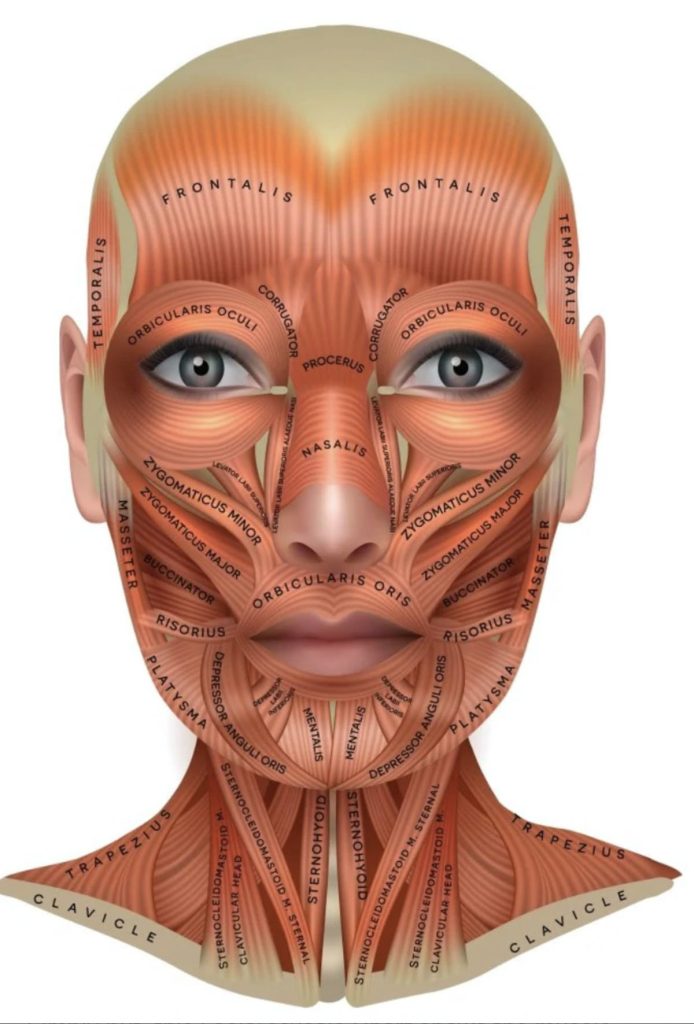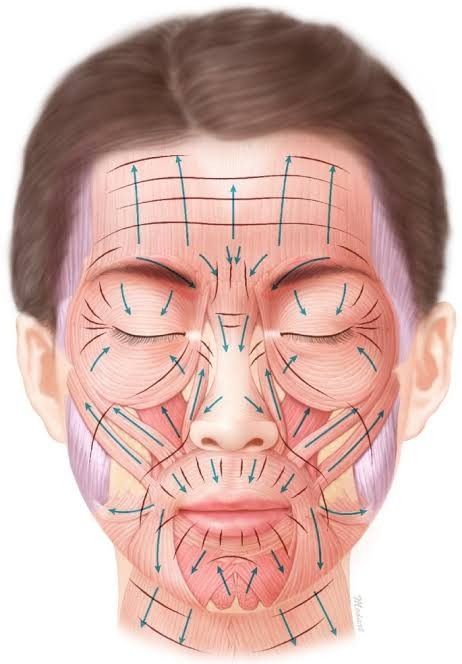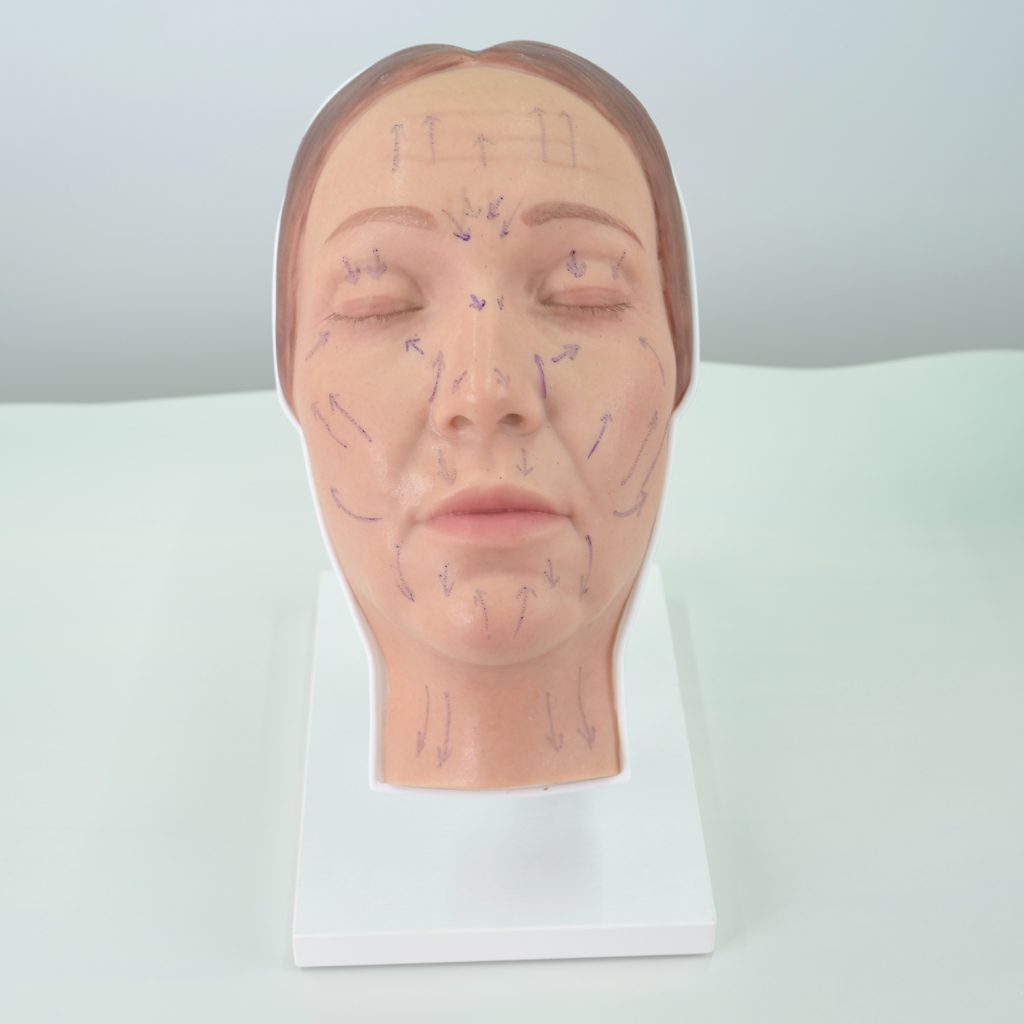Have you ever wondered why certain wrinkles appear as we age? The answer lies in the intricate network of facial muscles beneath your skin. Every smile, frown, or raised eyebrow involves these muscles contracting—and over time, repeated movements create dynamic wrinkles(visible with expressions) that eventually become static wrinkles (visible even at rest).
In this comprehensive guide, we’ll explore all the key facial muscles, how they contribute to wrinkles, and the most effective facial injection treatments—including botulinum toxin injections (like Botox®) and dermal fillers.
The Facial Muscles Behind Your Expression Lines
Your face has over 40 muscles, each playing a role in expressions and wrinkle formation. Below, we break them down by region:
1. Forehead & Brow Muscles
Frontalis (Forehead Wrinkles)
•Location: Covers the forehead from hairline to eyebrows.
•Function: Raises eyebrows (surprise, concern)
•Wrinkles formed: Horizontal forehead lines.
Temporalis (Jaw & Temple Tension)
•Location: Fan-shaped muscle at the temples.
•Function: Helps with chewing and jaw movement.
•Wrinkles formed: Can contribute to temporal hollowing and tension headaches.
Corrugator Supercilii (Frown Lines – “11 Lines”)
•Location: Between the eyebrows.
•Function: Pulls eyebrows downward and inward (frowning).
•Wrinkles formed: Vertical frown lines (“11 lines”).
Procerus (Horizontal Nose Wrinkles)
•Location: Bridge of the nose.
•Function: Pulls the skin between eyebrows downward.
•Wrinkles formed: Horizontal creases at the nasal root.
Depressor Supercilii (Inner Brow Drooping)
•Location: Inner brow area.
•Function: Lowers the inner eyebrows.
•Wrinkles formed: Deepens frown lines and creates a tired appearance.

2. Eye Area Muscles
Orbicularis Oculi (Crow’s Feet & Under-Eye Wrinkles)
•Location: Encircles the eye socket.
•Function: Closes eyelids (blinking, squinting).
•Wrinkles formed:Crow’s feet (outer eye wrinkles), Under-eye creases
Nasalis (Bunny Lines – Nose Wrinkles)
•Location: Along the sides of the nose.
•Function: Flares nostrils and wrinkles the nose.
•Wrinkles formed: ”Bunny lines” (horizontal wrinkles when scrunching the nose).
3. Midface & Smile Muscles
Levator Labii Superioris Alaeque Nasi (Upper Lip & Nostril Lift)
•Location: Runs from the nose to the upper lip.
•Location: Runs from the nose to the upper lip.
•Function: Raises the upper lip and flares nostrils.
•Wrinkles formed: Nasolabial folds (smile lines).
Levator Labii Superioris (Upper Lip Elevator)
•Location: Cheekbone to upper lip.
•Function: Lifts the upper lip.
•Wrinkles formed: Can deepen nasolabial folds.
Zygomaticus Minor (Subtle Smile Lines)
•Location: Cheekbone to corner of the mouth.
•Function: Assists in smiling.
•Wrinkles formed: Mild smile lines.
Zygomaticus Major (Full Smile & Laugh Lines)
•Location: Cheekbone to mouth corner.
•Location: Cheekbone to mouth corner.
•Function: Pulls mouth upward (smiling, laughing).
•Wrinkles formed: Nasolabial folds (deep smile lines),Marionette lines (if overactive)
4. Mouth & Chin Muscles
Orbicularis Oris (Lip Lines & Puckering)
•Location: Encircles the mouth.
•Function: Puckers lips (kissing, whistling).
•Wrinkles formed: Vertical lip lines (“smoker’s lines”), Perioral wrinkles
Modiolus (Corner of Mouth Stabilizer)
•Location: Junction of multiple facial muscles near the mouth.
•Function: Stabilizes mouth movements.
•Wrinkles formed: Can contribute to marionette lines.
Risorius (Grinning & Lower Face Tension)
•Location: Extends from cheek to mouth corner.
•Function: Pulls mouth sideways (grinning).
Wrinkles formed: Lower face tension lines.
Depressor Anguli Oris (Downturned Mouth Corners)
•Location: Jawline to mouth corners.
•Function: Pulls mouth corners downward (sad expression).
•Wrinkles formed: Marionette lines, ”Sad mouth” appearance
Depressor Labii Inferioris (Lower Lip Depressor)
•Location: Jaw to lower lip.
•Function: Pulls the lower lip downward.
•Wrinkles formed: Chin wrinkles (if overactive)
Mentalis (Chin Puckering – “Peach Pit Chin”)
•Location: Chin muscle.
•Wrinkles formed: Chin dimpling, ”Cobblestone” chin texture
5. Neck & Jawline Muscles
Platysma (Neck Bands & Jawline Sagging)
•Location: Extends from collarbone to jaw and lower face.
•Function: Tightens neck skin and pulls mouth corners downward.
•Wrinkles formed: Vertical neck bands (“platysmal bands”),Jawline sagging

Common Facial Injection to Treat Expression Lines
1. Botulinum Toxin (Botox®, Dysport®, Xeomin®)
•How it works: Temporarily relaxes overactive muscles.
•Results: Visible in 3-7 days, peaks at 2 weeks, lasts 3-4 months.
2. Dermal Fillers (Hyaluronic Acid Fillers)
•Best for: Static wrinkles (nasolabial folds, marionette lines, lip lines).
•How it works: Adds volume to smooth deep creases.
•Results: Immediate, lasts 6-18 months depending on the product.
3. Preventative Skincare
•How it works: Adds volume to smooth deep creases.
•Sunscreen: Prevents UV-induced collagen breakdown.
•Peptides & Growth Factors: Support skin elasticity.
Common Wrinkle Patterns in the Upper Face
The upper face is particularly prone to three main types of expression lines:
1.Horizontal forehead lines (caused by frontalis muscle activity)
2.Glabellar lines (vertical “11” lines between eyebrows)
3.Lateral canthal lines (crow’s feet at eye corners)
These wrinkles form through a combination of:
•Lateral canthal lines (crow’s feet at eye corners)
•Individual anatomical variations (unique muscle strength and bone structure)
•Skin aging processes (collagen/elastin breakdown)
Understanding Glabellar Contraction Patterns
Research shows people develop distinct glabellar wrinkle patterns based on their muscle activation:
Classification Systems:
1.de Almeida’s 5 Patterns (16):”U” shape, “V” shape, “Converging arrows”, “Omega” (Ω),”Inverted omega”
2.Kim’s Korean Patient Patterns (35):”U”, “11”, “X”,”Phi” (Φ),”I”
These variations occur because different people use their glabellar complex muscles (corrugators, procerus, depressor supercilii) in unique combinations, sometimes with assistance from:
•Frontalis (forehead muscle)
•Nasalis (nose muscle)
•Orbicularis oculi (eye muscle)
Treatment Implications
The specific botulinum toxin (BTX-A) injection pattern must be customized based on:
1.The patient’s dominant wrinkle pattern
2.Their unique muscle activation map
3.Desired aesthetic outcomes
For example:
•”U” pattern patients may need stronger corrugator treatment
•”Omega” pattern often requires balanced procerus and depressor supercilii dosing
•”11″ pattern typically focuses on medial corrugator injections
This personalized approach explains why:
✔ Experienced practitioners assess muscle movement before treating
✔ Standard “cookie-cutter” injection patterns often yield suboptimal results
✔ Follow-up adjustments are frequently needed
Precision Matters: The Role of a Facial Injection Mannequin
Administering botulinum toxin requires expert knowledge of facial anatomy to avoid complications like eyelid drooping (ptosis) or uneven results. That’s why many practitioners train using a facial injection mannequin—a lifelike model that helps perfect injection techniques before treating real patients.
Why Training with a Mannequin Helps:
✔ Practices muscle targeting (e.g., avoiding the levator palpebrae to prevent ptosis)
✔ Improves injection depth & dosage accuracy
✔ Reduces risks of bruising or asymmetry

(Facial injection mannequin head for teaching and learning)
(reference:
